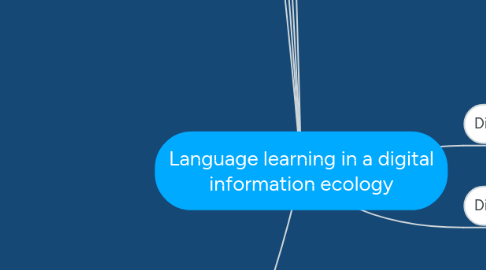
1. Language Learning Ecology
1.1. Participants
1.1.1. Student
1.1.1.1. Affect
1.1.1.1.1. Motivation
1.1.1.1.2. Attitude
1.1.1.1.3. Perserverence
1.1.1.2. Personality
1.1.1.2.1. Extroversion
1.1.1.3. Skills / Ability
1.1.1.3.1. Previous experience
1.1.1.3.2. Learning Hacks
1.1.1.3.3. Attention
1.1.1.3.4. Memorisation
1.1.1.4. Goals
1.1.1.4.1. Personal
1.1.1.4.2. Pedagogical
1.1.2. Teacher
1.1.2.1. Pre-service training
1.1.2.2. In-service training
1.1.2.3. Skills & Tools
1.1.2.3.1. Gaps in pedagogy / technology?
1.1.3. School (other Teachers)
1.1.3.1. Attitude
1.1.3.2. Understanding
1.1.3.3. Skills & Tools
1.1.4. Community
1.1.4.1. In school
1.1.4.2. Out of school
1.1.5. Family
1.1.5.1. Encourage
1.1.5.2. Impede
1.1.5.3. Parents
1.1.5.3.1. Involvement
1.1.5.3.2. Expectations
1.1.5.3.3. Educational background
1.1.5.3.4. Socio-Economic Status
1.1.5.4. Siblings
1.1.5.5. Extended Family
1.2. Environment
1.2.1. Affordances
1.2.1.1. Authentic Material
1.2.1.1.1. Synchronous
1.2.1.1.2. Accessible
1.2.1.2. participation
1.2.1.3. Socialisation
1.2.1.4. Feedback
1.2.1.5. Coherence
1.2.1.5.1. Local
1.2.1.5.2. Global
1.2.2. Mediated?
1.2.2.1. Common Ground Theory
1.2.3. Formality
1.2.3.1. Curriculum / Assessment
1.2.3.1.1. Informal
1.2.3.1.2. Formal
1.3. Philosophy
1.3.1. Socio-cultural
1.3.2. Pedagogical
1.3.2.1. Taxonomy
1.3.2.2. Tool
1.3.2.2.1. Language tools
1.3.2.3. Task
1.3.2.4. Design
1.3.3. Identity
1.4. Language
1.4.1. Native / mother tongue
1.4.2. Second Language
1.4.3. Heritage Language
1.4.4. Bilingual
2. Questions
3. Ecological Linguistics
3.1. Context Situated
3.1.1. Context
3.1.1.1. Microsystem
3.1.1.1.1. Social Interaction
3.1.1.2. Mesosystem
3.1.1.2.1. Multiple interrelated microsystems
3.1.1.3. Exosystem
3.1.1.3.1. Resource availability in various settings
3.1.1.4. Macrosystem
3.1.1.4.1. Sense of identity and of language learning
3.2. Relational
3.2.1. Learner /Environment negotiation
3.3. Functional
3.3.1. Interaction and socialisation
3.3.1.1. Community of Practise (COP)
3.3.1.2. Individual Network of Practise (INoP)
